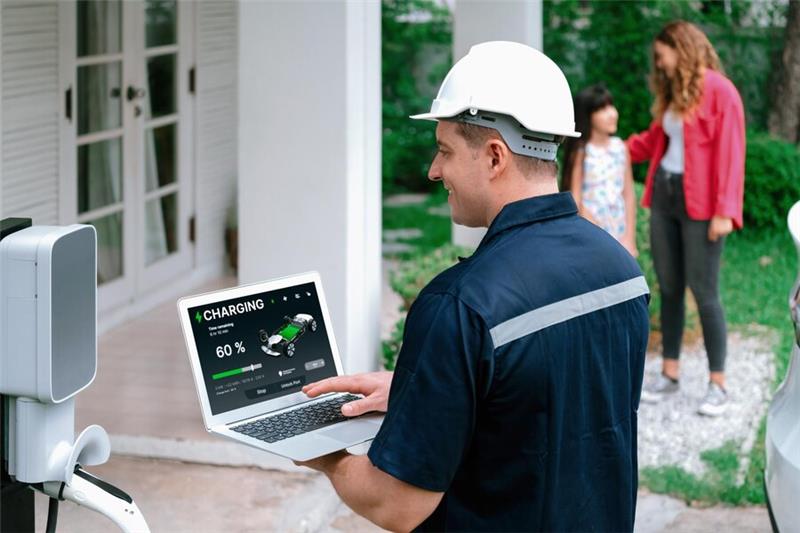Introduction
High Voltage Direct Current (HVDC) transformers lie at the heart of modern electrical grids. As conduits for transferring enormous amounts of power across vast distances, their efficiency and reliability are paramount. The surge in renewable energy sources, evolving grid architectures, and the global push for sustainable energy solutions underline the growing importance of HVDC systems. However, with increased significance comes the amplified need for meticulous monitoring. Electrical asset monitoring software emerges as a pivotal tool, bridging the gap between operational excellence and predictive maintenance for these electrical giants. This article delves into the intricate world of HVDC transformers and the indispensable role of monitoring software in preserving their health and functionality.
Specific Requirements and Characteristics of HVDC Transformers
HVDC transformers, by their very nature, are distinct from traditional AC transformers. This distinction arises from the challenges and demands inherent to direct current transmission. As the backbone of long-distance and cross-border power systems, the HVDC transformer’s design and operational requirements are tailored to ensure reliability, efficiency, and durability. Let’s delve into the specific requirements and unique characteristics that set these transformers apart.
1. Handling Harmonics:
Harmonics, or the multiple integer frequencies of the fundamental power frequency, can pose significant challenges in HVDC systems. The HVDC transformer must be designed to manage these harmonic currents effectively. This involves specialized winding configurations and the use of filters to ensure that harmonics do not interfere with the transformer’s operation or the stability of the grid.
2. Prevention of Core Saturation:
Core saturation is a state where the transformer’s core magnetic flux density exceeds its design limit. To prevent this phenomenon, HVDC transformers are equipped with a robust magnetic core, often utilizing high-grade electrical steel. This ensures that the transformer can handle the high power levels characteristic of direct current transmission without risk of saturation.
3. Robust Insulation Systems:
Given the high voltages involved, HVDC transformers demand superior insulation systems. This is not just about preventing electrical breakdowns but also ensuring the transformer’s longevity. High-grade insulating materials, coupled with meticulous design considerations, ensure that these transformers can operate safely and efficiently in the demanding HVDC environment.
4. Advanced Cooling Mechanisms:
The efficiency of an HVDC transformer is intrinsically linked to its temperature management. Effective cooling systems, whether oil-based or advanced air-cooled methods, are integral. By maintaining optimal operating temperatures, these cooling systems ensure the transformer’s efficiency and prolong its operational lifespan.
5. Tailored Winding Configurations:
The windings in an HVDC transformer are designed to handle high currents and voltages. Special winding techniques, often bifilar or interleaved, are employed to minimize losses and ensure the transformer’s reliability.
While understanding these specific requirements is essential, it’s equally critical to recognize the crucial role of monitoring these HVDC transformers. Electrical asset monitoring software emerges as a game-changer in this context. By providing real-time insights into the transformer’s health, performance metrics, and potential issues, this software ensures that any deviations from the norm are promptly identified. The ability to pre-emptively address these issues, facilitated by monitoring software, underscores the importance of merging technical excellence with advanced technological solutions.
For stakeholders ranging from electrical engineers to software developers, this integration not only promises operational excellence but also charts the path for sustainable and reliable power systems.
The Importance of Monitoring HVDC Transformers
The HVDC transformer, a cornerstone in the architecture of modern power transmission systems, plays a pivotal role in ensuring efficient, long-distance energy transfer. As the demands on our power infrastructure intensify, with an increasing push towards renewable energy and the need for cross-border energy exchanges, the reliability of these HVDC transformers becomes paramount. This underscores the crucial role of monitoring HVDC transformers.
1. Ensuring Operational Efficiency:
An HVDC transformer’s efficiency directly impacts the overall efficiency of the power transmission system. By monitoring key performance indicators like temperature, voltage levels, and current flows, potential inefficiencies can be identified and rectified promptly. Electrical asset monitoring software provides real-time data, allowing operators to make adjustments that ensure the transformer operates within optimal parameters.
2. Predictive Maintenance:
One of the standout benefits of advanced monitoring is the shift from reactive to predictive maintenance. Instead of addressing issues after they manifest, monitoring tools, especially those integrated with machine learning capabilities, can predict potential failures or wear and tear. This proactive approach minimizes downtime, reduces maintenance costs, and extends the transformer’s lifespan.
3. Safety and Risk Management:
HVDC transformers operate under high voltages and currents. Any malfunction or failure can pose significant safety risks, not just to the equipment but also to the personnel involved. Continuous monitoring acts as an early warning system, alerting operators to anomalies that could escalate into safety hazards.
4. Cost Savings:
Unexpected downtimes or catastrophic failures can result in significant financial burdens, from equipment replacements to loss of transmitted energy. Monitoring tools ensure that HVDC transformers operate efficiently, pre-empt potential issues, and thereby offer significant cost savings in the long run.
5. Data-Driven Decision Making:
With the integration of electrical asset monitoring software, a wealth of data is available to operators and decision-makers. This data, when analyzed, provides insights into the HVDC transformer’s performance, wear patterns, and potential areas of concern. Such data-driven insights are invaluable for strategic planning, upgrades, and ensuring the transformer’s longevity.
Given the HVDC transformer’s significance in power transmission, the integration of electrical asset monitoring software becomes non-negotiable. These software tools, tailored for the unique requirements of HVDC systems, offer a comprehensive overview of the transformer’s health and performance. For stakeholders, from electrical engineers to facility managers, understanding and harnessing the power of these monitoring tools is not just a technical imperative but a strategic one. As the energy landscape evolves, the synergy between HVDC transformers and their monitoring systems will define the trajectory of efficient, reliable, and sustainable power systems.
Modern Techniques and Technologies for Monitoring
In the dynamic realm of power transmission, particularly concerning the HVDC transformer, monitoring is not a mere luxury but a necessity. As the complexities and demands of modern electrical grids escalate, so does the imperative for advanced monitoring techniques and technologies. These tools not only ensure the efficient operation of the HVDC transformer but also pre-empt potential challenges.
1. Advanced Sensors and IoT Integration:
Modern HVDC transformers are often equipped with a suite of advanced sensors capable of measuring various parameters, including temperature, voltage, current, and vibration. When integrated with Internet of Things (IoT) devices, these sensors can relay real-time data to centralized monitoring systems, ensuring continuous oversight of the transformer’s health and performance.
2. Machine Learning and Predictive Analytics:
The true potential of electrical asset monitoring software is unlocked when combined with machine learning algorithms. By analyzing historical and real-time data, these algorithms can predict potential issues, wear patterns, and inefficiencies. Predictive analytics, in particular, offers a proactive approach to maintenance, identifying problems even before they manifest, thereby reducing downtimes and ensuring optimal performance.
3. Cloud-Based Monitoring Systems:
Cloud technology has revolutionized how data is stored, accessed, and analyzed. Modern monitoring systems often leverage cloud platforms, allowing operators and stakeholders to access the HVDC transformer’s data from anywhere, anytime. This ensures that even if a transformer is located in a remote area, its performance metrics are readily available for analysis and decision-making.
4. Digital Twin Technology:
Digital twin technology involves creating a virtual replica of the physical HVDC transformer. This digital model is continuously updated with real-time data, offering a comprehensive overview of the transformer’s health, performance, and potential issues. Engineers and operators can simulate various scenarios on this digital twin, testing solutions and strategies without impacting the actual transformer.
5. Integrated Alarm Systems:
Modern monitoring tools come equipped with integrated alarm systems. Should any parameter deviate from its optimal range or a potential issue arise, these alarm systems ensure immediate notification to the concerned personnel. This rapid response capability is vital for pre-empting and addressing challenges, ensuring the HVDC transformer’s longevity and reliability.
The integration of these modern techniques and technologies underscores the crucial role of monitoring HVDC transformers. As the energy landscape evolves, the synergy between the HVDC transformer and its monitoring systems will be a defining factor in ensuring efficient, reliable, and sustainable power transmission. For stakeholders ranging from electrical engineers to software developers, embracing these advanced monitoring solutions is not just a technical imperative but a strategic one, shaping the future of power systems.
Future Outlook and Recommendations
The world of power transmission, particularly centered around the HVDC transformer, is in a state of rapid evolution. As technological advancements continue to reshape the landscape, the importance of efficient and proactive monitoring systems becomes even more pronounced. The future promises a blend of challenges and opportunities, and here’s a glimpse into what lies ahead, coupled with recommendations to navigate this dynamic terrain.
1. Integration with Renewable Energy Sources:
The global energy landscape is witnessing a shift towards renewable sources. As wind farms, solar parks, and hydropower installations become more prevalent, the HVDC transformer will play a pivotal role in integrating these sources into the main grid. The intermittent nature of some renewables necessitates advanced monitoring systems to ensure stable power transmission.
2. Advancements in Monitoring Technologies:
As the Internet of Things (IoT), Artificial Intelligence (AI), and machine learning technologies mature, their integration into monitoring systems will become more seamless. This promises even more accurate predictive maintenance, fault detection, and efficiency optimization.
3. Decentralized Power Generation and Microgrids:
The future may see a rise in decentralized power generation and the development of microgrids. While this promises more resilience and efficiency, it also means that multiple HVDC transformers might operate in tandem, necessitating synchronized monitoring.
4. Regulatory and Compliance Changes:
As the energy sector evolves, so will the regulatory landscape. Compliance with safety, environmental, and operational standards will become more stringent, requiring meticulous monitoring and reporting.
5. Enhanced Collaboration:
The future will require enhanced collaboration between equipment manufacturers, software developers, utility companies, and regulatory bodies. This collaborative approach will ensure that monitoring systems are comprehensive, efficient, and in line with industry best practices.
In essence, the HVDC transformer, with its pivotal role in power transmission, will continue to be at the forefront of the energy revolution. Its symbiotic relationship with advanced monitoring systems will define the future of efficient, reliable, and sustainable power systems. As we move forward, embracing technological advancements and fostering collaboration will be key to harnessing the full potential of HVDC transformers and their monitoring systems.
Conclusion
HVDC transformers, the linchpins of modern electrical grids, command unparalleled attention. Their pivotal role in sustaining energy demands necessitates rigorous monitoring. In this landscape, electrical asset monitoring software emerges as an invaluable ally, ensuring the health and efficiency of these transformers. The integration of cutting-edge technologies, coupled with a proactive approach, paves the way for a resilient and efficient electrical grid system. As we forge ahead, the synergy between HVDC transformers and advanced monitoring solutions will define the trajectory of sustainable energy solutions. Stakeholders across the spectrum, from asset managers to software developers, hold the collective responsibility to champion these synergies, preserving our grids and shaping a brighter, energy-efficient future.




